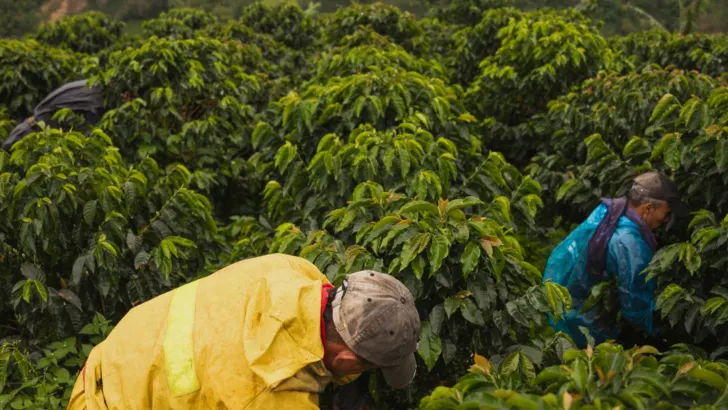Table of Contents
There’s a battle brewing and it’s between single-origin coffee vs blends. Both have their loyal fans, but which one is the ultimate champion?
Single-origin coffee is made up of beans from a single geographic location. Coffee blends are made up of multiple origins, often mixed to create a unique flavor profile.
So, what are the key differences between these two types of coffee? Keep reading to find out!
What Is Single Origin Coffee?
Single-origin coffee is a type of coffee that has been sourced from one single geographic origin. This means that the beans all come from the same farm or region, instead of being blended together from different origins.
The term was coined in the early 2000s and refers to a higher quality of coffee than traditional blends, which can be a mix of different beans from different regions.
Single-origin coffee is typically described as having bolder flavors, brighter acidity, and more distinct aromas than your average cup. It’s because each region has specific growing conditions that affect the taste and aroma of the beans in different ways.
For instance, if you compare two coffees grown in Ethiopia to one grown in Costa Rica, they will have very distinct flavor notes.
The harvesting process also plays an important role when talking about single-origin coffees.

The practice of selective harvesting ensures only ripe cherries are picked for processing – resulting in uniform ripeness levels of the final product.
As a result, this brings out more nuanced flavors and deeper complexity to single-origin coffees vs blends which can be made up of cherries with varying ripeness levels due to their multiple sources.
Finally, it’s worth noting that many single-origin coffees are also certified organic or fair trade – meaning farmers receive fair wages for their product as well as adhere to sustainable practices as mandated by these labels.
This helps ensure both the ethical treatment of workers as well as environmental sustainability for future generations!
What Are Coffee Blends?
Coffee blends are mixtures of two or more different types of coffee beans that are roasted and then combined together to create a unique flavor.

Often, coffee blends will contain beans from multiple countries with different characteristics, such as aroma, acidity, sweetness, and body. The purpose of blending is to combine the best attributes of each type of bean and make something new!
The art of blending coffee involves several steps. First, a master blender will select particular kinds of beans from various origins and roast them separately.
This allows the individual characteristics to shine through without competing with each other. Then they will be blended together in various ratios until just the right combination has been achieved.
The result is often a complex flavor profile that may contain notes of chocolate, nuts, spices, fruits, or even flowers.
It can also bring out subtler notes that would not be apparent if only one type of bean was used.
Blending also allows for consistency in flavor from batch to batch; since the same ratios are used for each blend, you can expect similar flavors whether you buy it fresh or months later.
When shopping for coffee blends it’s important to pay attention to the origin information on the label so you know what kind of beans have been used in the mix.
You should also consider how strongly the blend has been roasted – light roast blends are usually more acidic while dark roasts have richer flavors but less acidity – so that you get just what you’re looking for when it comes time to brew your cup!
What Are The Key Differences Between Single Origin Coffee vs Blends?
As stated above, single-origin coffee is a type of coffee that is sourced from a particular farm, region, or country. They are produced by small-scale farmers, and can have distinct flavor profiles and unique characteristics.
Single-origin coffees are harvested in season and roasted to order so that the customer gets the freshest cup possible.
Compared to blended coffees, single-origin coffees offer more complexity of flavors, but they also tend to be more expensive due to their limited availability.
Blended coffees are a combination of two or more different types of beans from different regions. This allows roasters to create unique flavor profiles that can’t be achieved with single-origin beans.
Blends also tend to be less expensive than single-origin coffees because the cost is spread out among multiple origins. Roasters combine certain flavors together for balance and uniformity in the cup.
The key differences between single-origin coffee and blends come down to taste, cost, and availability.
Taste
Single-origin coffees usually taste brighter and more complex than blends since each bean offers its own unique characteristics, however, these coffees are often harder to get hold of and can be much pricier than blends due to the limited supply per harvest season.
On the other hand, blends combine different beans from various origins which creates an interesting mix of flavors that can often appeal to broad audiences due to its balanced taste profile, however, this type of coffee isn’t as special in terms of individual bean character as each component plays more of a supporting role in the blend’s overall flavor profile.
Cost
In addition, blends offer more affordability when compared with single origins since there’s no pressure on any one particular bean type or region being featured in each batch – thus allowing for better economies of scale in production costs.
Availability
Moreover, blended coffees have somewhat higher availability since roasters can access larger supplies year-round without sacrificing quality over time; yet this comes at the expense of individual bean character which makes them less interesting on the palate than their single-origin counterparts.
Finally, single-origin coffees are often in high demand as they’re rarer and more limited in supply because each farm typically produces only one harvest season per year.
This means that this type of coffee can be harder to get hold of if you don’t purchase them at the right time.
Single Origin Coffee Vs Blends: Which One Is Right For You?

For coffee lovers eager to sample the extraordinary tastes and nuances from different parts of the world, single-origin coffee is an ideal option.
For those just starting out, a solid blend of coffee is the perfect way to start your journey! You’ll find these coffees accessible and enjoyable with their well-rounded flavor profiles.
Whether you are looking for unique flavors or affordability, it is up to the individual to decide which type of coffee is right for them.
Single-origin coffees offer a unique experience with each cup, as each bean’s flavor profile has been carefully crafted and selected by the roaster to ensure that the highest quality product is enjoyed by the customer.
Blends, on the other hand, provide a more uniform flavor profile and can be easier to find due to their year-round availability. In addition, they are often more affordable than single-origin coffees.
Both single-origin coffees and blends offer unique flavor profiles and have their own set of advantages and disadvantages. Ultimately, it is up to you to decide which type of coffee will best suit your needs.
Regardless of what you choose, both types offer something special that can be enjoyed for years to come.
Final Thoughts
Whether you’re looking for complexity of flavor or affordability, there is a coffee out there for everyone.
So the next time you’re trying to decide between single origin and blends, consider each one’s characteristics and choose the option that best suits your needs and budget.
After all, no matter what kind of coffee you choose, you can always count on an enjoyable cup.
Happy brewing! Happy sipping!
P.S. Be sure to check out our other coffee-related articles for more information, as well as more tips and tricks on making the perfect cup of joe and to learn “All About That Coffee!”

